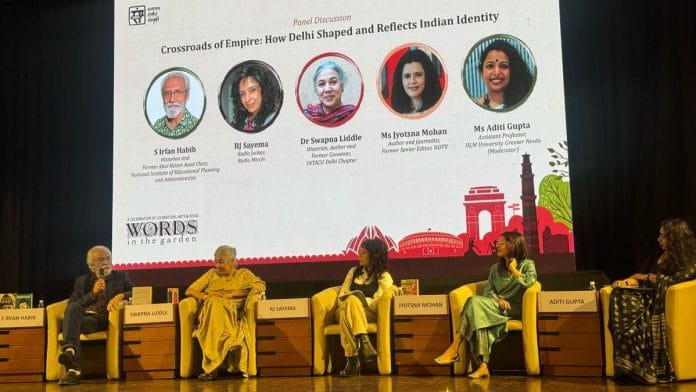New Delhi: Delhi is a city of migrants, but who are the real Dilliwalas? A panel of historians, a radio jockey, and a journalist gathered to discuss the question—and to lament that Delhi’s original inhabitants are now almost invisible.
“Where are the Dilliwalas? You can’t even see them. Now, we see people who have come from all corners of India and have become Dilliwalas,” said historian Irfan Habib. His concern was that Delhi is now seen more as a city of opportunity than one of history
“Delhi is multi-layered, and we don’t care to learn about it. That is a real misfortune because it is a very special city,” Habib continued, as the audience, comprising students, historians, and culture aficionados burst into applause.
The panel discussion, ‘Crossroads of Empire: How Delhi Shaped and Reflected Indian Identity’, was held at the India International Centre as part of the Words in the Garden festival, organised from 28 February to 2 March by Sanatan Sangeet Sanskriti and IILM University.
It was an evening when Delhi was humanised, eulogised, and romanticised. While historians Irfan Habib and Swapna Liddle spoke about its history, RJ Sayema and journalist Jyotsna Mohan reimagined the city through its resilience, resistance, and culture.
“Before Delhi became a major capital, it was a crucial crossroads where travellers passed through. Ashoka even placed an inscription here, similar to ancient highway markers, reflecting its importance,” said Liddle.
For RJ Sayema, however, Delhi is the truest representation of India.
“As an RJ, I find it difficult to meet a person, a true Delhiite, who doesn’t carry Delhi within them. It’s not just a geographical space but an emotion—a confluence of cultures and identities,” she said.
But what makes someone a Dilliwala? Habib posed the question, arguing that despite ongoing political debates over Urdu, it remains integral to Delhi’s heritage. His comment subtly alluded to Uttar Pradesh Chief Minister Yogi Adityanath’s recent claim in the UP Assembly that the Samajwadi Party wanted to promote Urdu to make children maulvis.
“The Dilliwalas claim that they played a significant role in the development of Urdu,” Habib said.
Also Read: Indian languages are ‘father tongues’. Migrant men played a big role
When science spoke Urdu
Delhi was also a city where modern science emerged in the vernacular, according to Habib.
While Bengalis took to English in a big way, Urdu became a medium through which modern science was communicated in Delhi, he pointed out. And at the forefront of this was Master Ramchandra, a 19th-century Indian mathematician, social commentator, and Urdu journalist. A student of Delhi College and a member of the Vernacular Translation Society, he was instrumental in translating and publishing scientific works in Urdu.
“So, Delhi was a place which saw the emergence of this group of people who produced scientific texts in Urdu—the people’s language of those times,” said Habib.
His historical insight into Delhi’s connection with Urdu seemed to leave the audience enthralled, with many students leaning forward and listening intently.
Habib further revealed that Ramchandra had a student who continued this legacy, translating English works on mathematics and science into Urdu.
Urdu may be embattled now, but a culture informed by it lingers in the gullies of Shahjahanabad.
Also Read: Urdu daily ‘Pratap’ was shut in just 12 days of launch. It taught us real journalism
Dual identities
Historian Swapna Liddle described Delhi as two cities: the Mughal-era walled city of Shahjahanabad and the British-built New Delhi. Both, she said, echo different eras through their architecture, streets, and how people once lived.
“Chandni Chowk is very different from the India International Centre— this shows how they represent different parts of Delhi’s past. The gullies of Shahjahanabad foster a different kind of lifestyle,” said Liddle.
Habib had another slice of history to share—this one about Bhagat Singh. Hours before Singh bombed the Central Legislative Assembly in 1929, he met his comrades at the walled city’s Qudsia Bagh. He savoured oranges, his favourite fruit, that a female associate had brought for him. From there, he went straight to the Lutyens-designed assembly and carried out the attack.
“How much do we care to know about this bagh as we pass ISBT?” he asked.
As the event drew to a close, the floor was opened for the audience to ask questions. A man from France posed an unexpected one to the panellists: “Why doesn’t India have one language? Shouldn’t there be a language to unify the people?”
“I was in the South and people there couldn’t understand Hindi. I came to the North and people here don’t understand the southern languages,” he said.
Habib had a ready answer: “Not politically, but we were a nation centuries ago. With all the diversity, with all the different languages. And we saw ourselves as Indians.”
But it was Sayema’s response that gave everyone a good laugh. “And we also have English in our list of languages. We have such a big heart.”
(Edited by Asavari Singh)







Historian is S. Irfan Habib and not Irfan Habib. Irfan Habib won’t ever be a part of such mediocre discussion.